I’ve just spent a week in North Carolina at the recent Trek Bikes press camp to see what they have been working on recently.

(Here’s the previous teaser article about the trip.)
What’s new with Trek?
Trek pulled few new things out of their sleeves at this one:
– An updated Lush range in 27.5″
– The new Carbon Remedy 29er featuring Boost 148 technology
– The much-loved Trek Fuel 26″ moves to 27.5″
But most importantly we were there to witness the dawn of new relationship in the MTB industry as Trek Bikes unite with Penske Racing Shocks and Fox Suspension.
This collaboration has apparently been five years in the making, with nearly half of that time developing the new RE:AKTIV technology. Bringing Penske to the table gives Trek the best access to cutting-edge automotive technology, and Fox are there to do the mass production, distribution and worldwide after-sales care.
About Penske Racing Shocks
Penske Racing shocks are renowned in the world of car racing, specialising in bespoke suspension products. No mass production, just hand-built custom units. Formula 1, NASCAR, Indy Car, Supercross and more, customers include Mercedes-Petronas, Force India and Caterham F1 teams.
Due to Penkse’s focus on racing, they have no mass-production facilities, and this is where Fox come in. Being one of the biggest suspension manufacturers in the MTB world, they were the perfect partners for Trek to approach to adapt a new technology into the existing suspension chassis, then produce, ship, and offer worldwide after-sales and warranty backup.

About RE:AKTIV suspension
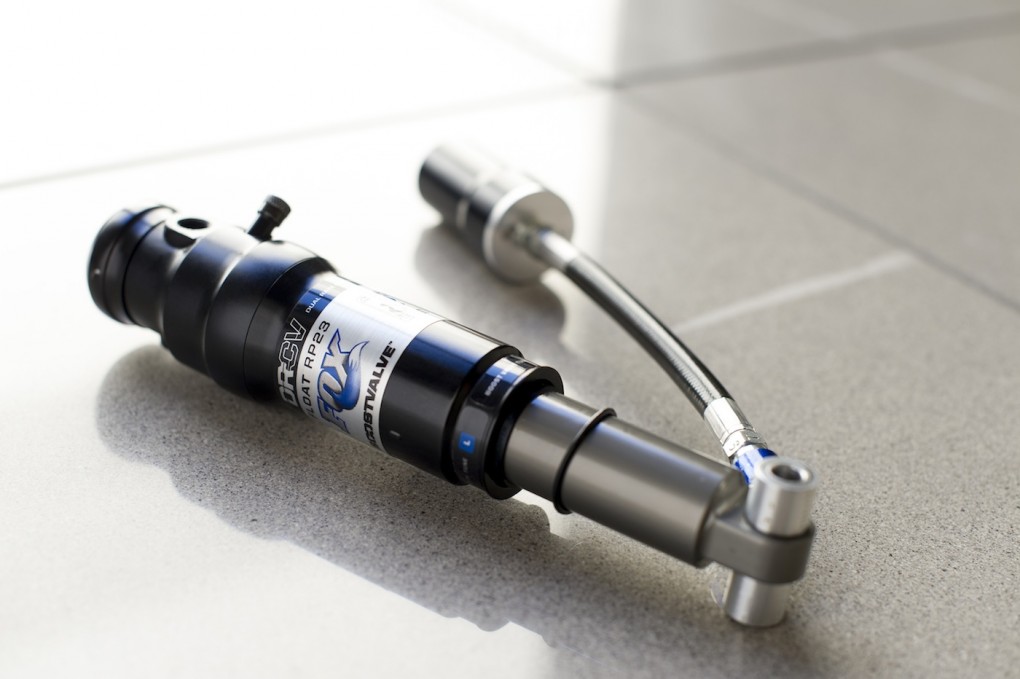
Wondering what RE:AKTIV is? Trek’s marketing guys explained it thus so:
RE:AKTIV Regressive Damping is a no compromise between low-speed compression damping support for rider confidence and high-speed compression damping for control. And the ability to transition seamlessly, immediately.
I’ll try to decipher: RE:AKTIV is a “regressive” suspension design, developed in motor racing for drivers who wanted a firm ride and feel for throwing the cars into corners, and for the engineers and analysts who wanted a supple ride to maximise rubber to tarmac interface for increased grip. This new damper is an addition to Trek’s DRCV (Dual Rate Control Valve) technology, which is the spring.
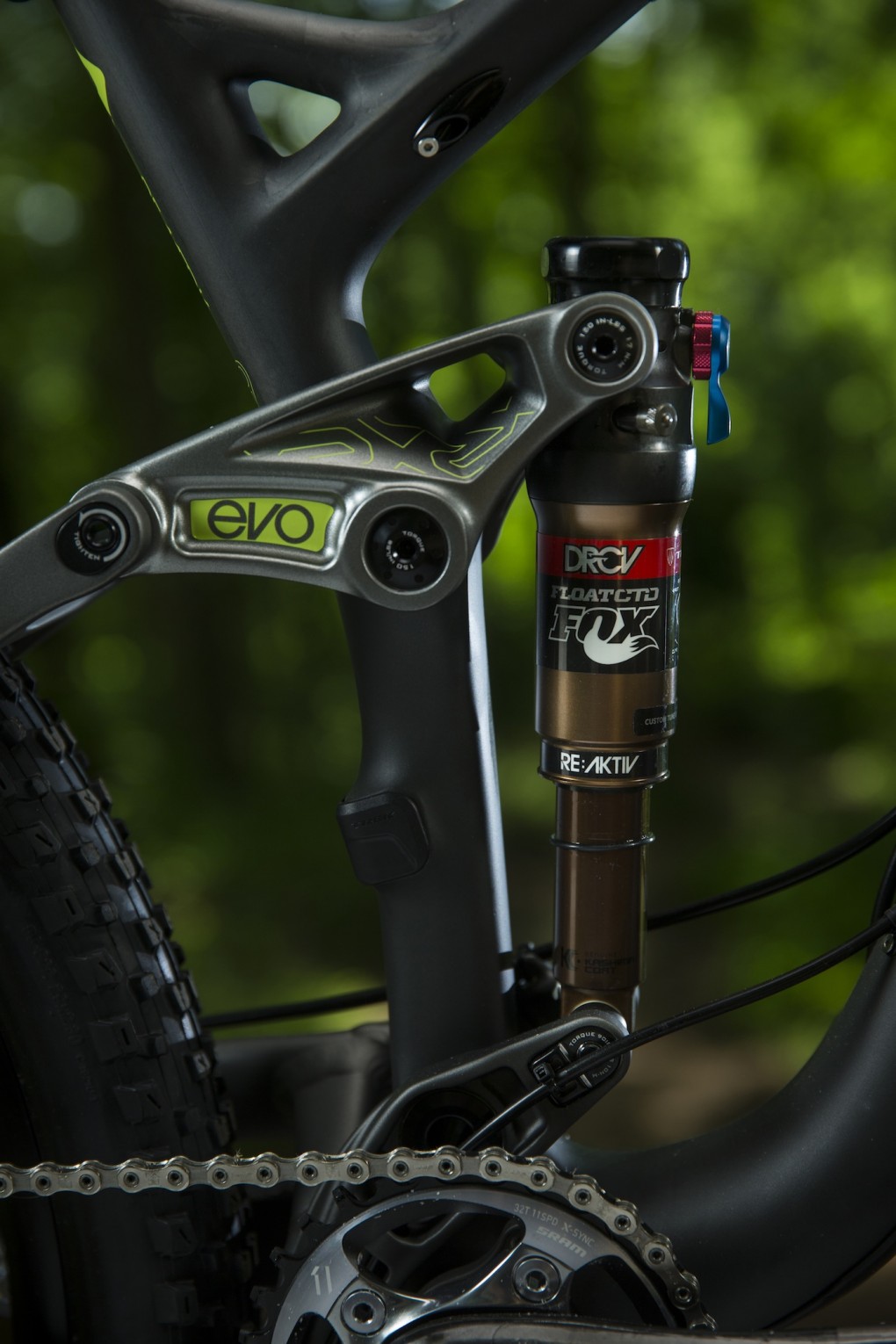
How does this theory transfer over from a Formula 1 car to your MTB? You get a firm ride and efficient pedalling with enough sensitivity to help grip when climbing over roots or rocks. Enhanced support for pre-loading into jumps, pumping and turning, but with the suppleness to achieve maximum grip and absorption when things get choppy.

Admittedly I only spent a relatively short amount of on-the-bike time with the RE:AKTIV, but initial impressions showed a positive improvement on existing Fox CTD (Climb, Trail, Descend) units. There was a marked difference in damping between settings, with the Climb mode benefiting from the most noticeable improvement to pedalling dynamics and Trail finally becoming a great middle-ground between efficiency and absorption, good enough to be used for 95% of our ride. Descend is the least affected compared to previous versions as Trek wanted this setting to retain its existing downhill characteristics.
Fox have also been deeply involved in this product. Their job was to take the principles created between Trek and Penske, and package it into an existing Fox unit, guarding the characteristics but taking it to a mass-production level. Fox build and ship the product, and provide after-sales and warranty care worldwide. So no need to worry about having a niche product and struggling to source parts when you break something in the middle of you riding holiday.

RE:AKTIV is now available on Fuel, Lush and Remedy bikes. But in the future it could well be appearing on front suspension and even DH bikes, although Trek had no official words on when this may become a reality.
Updated Fuel EX and Lush Ranges

Trek have replaced the much-loved 26″ Fuel with a new 27.5″ platform. The Fuel is Trek’s 120mm Trail bike, light enough for XC use, even occasional racing, yet aggressive enough for some good fun on the downs. Dylan from Trek says initially they didn’t want to change to 27.5″ because they all loved their 26″ Fuels so much! So they built three identical bikes in all three wheel sizes to put the debate to bed, thinking the differences in the medium wheels would be negligible. However, during testing there was a unanimous preference towards the 27.5″ (yes we’ve heard this story before too, but it’s probably true) both in rider feedback and more scientific testing. Is this the final nail in the coffin for 26″ trail bikes?
The Fuel EX is the flagship model for RE:AKTIV technology and will be available on all 9 models, down to the £3000 price point.
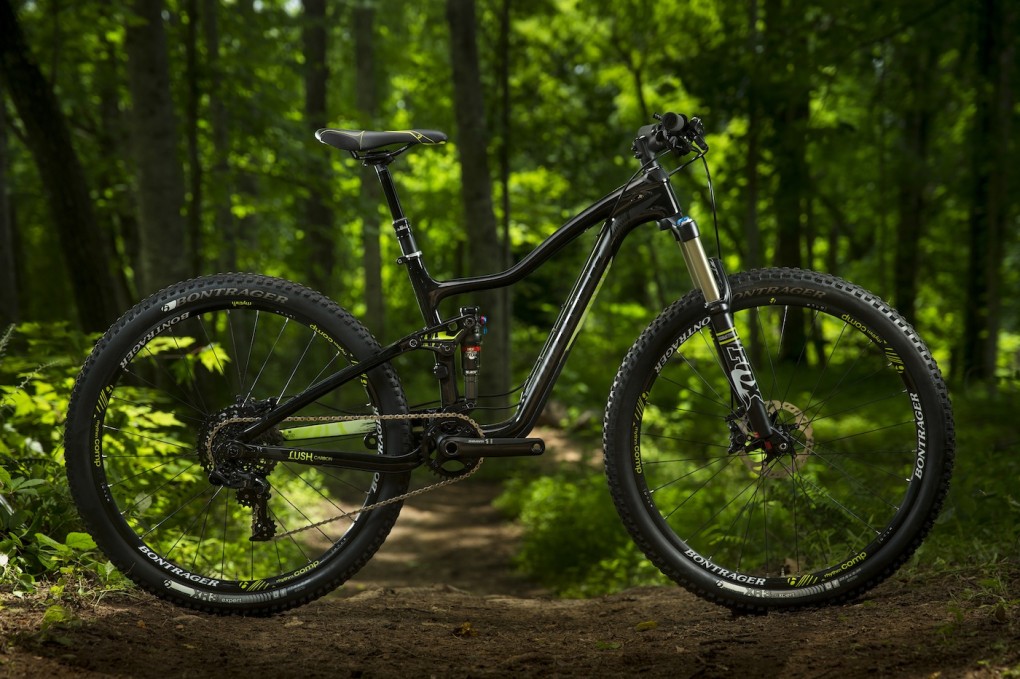
RE:AKTIV will also be available on the female-specific Lush range, which also benefits from 27.5″ wheels, and the new Remedy Carbon 29er range.
Boost 148 and Remedy Carbon 29 – new hub system
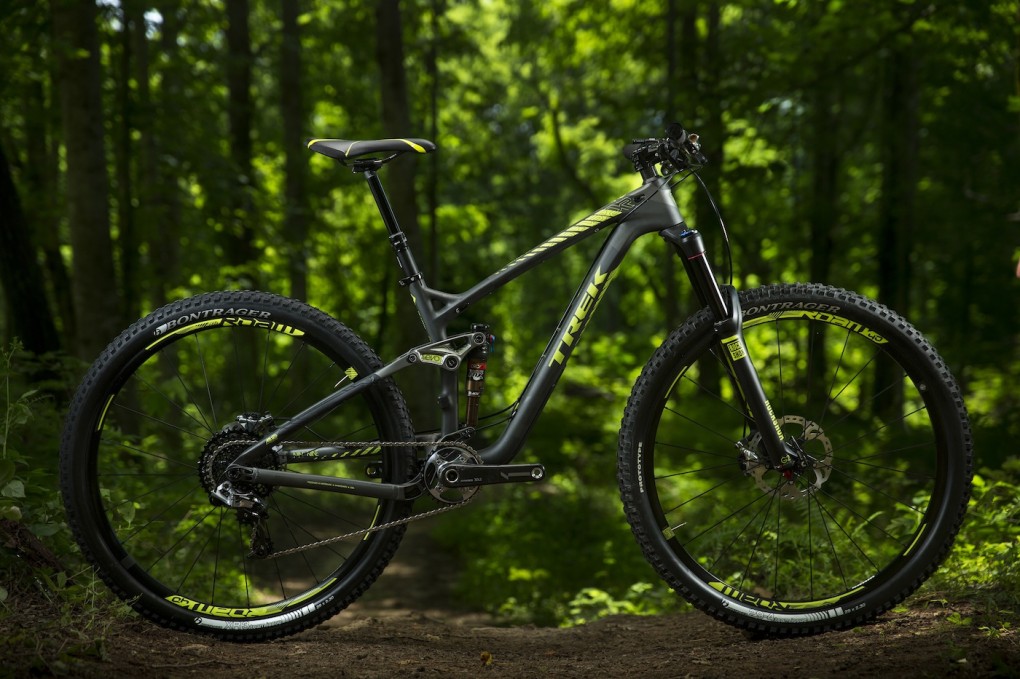
Another hub standard, this will probably ruffle a few feathers of the keyboard warriors. Trek says that this new standard is “The 29er Perfected” and improves upon a number of issues for 29ers.
Wheel stiffness is a widely discussed issue when it comes to big-hitting 29ers.
Boost 148 is basically a wider rear hub, designed to give the stiffness of a smaller wheel with no added weight penalty. This is matched to a modified chainring to keep your chain in line and guard the all-important Q-factor.
This wider rear hub gives the spokes a wider bracing angle, 3mm each side. This doesn’t sound dramatic but Trek says this 6mm total is actually a huge difference and achieves the stiffness of 27.5″ wheel on a 29er. Why isn’t this technology utilised on 27.5″ bikes? Well they already offer the stiffness required.
29″ wheel strength isn’t really affected by the length of the spokes, but the fact that as the spokes lengthen and the hub stays the same size means you have less bracing angle. It could be likened to a stepladder; if you don’t open it all the way it’s going to be a bit wobbly but the further you open it the more support it gives you. At the press camp, some people asked, “Cant you just make the spoke flange wider?” Trek’s response was that to gain the extra stiffness achieved by the width, the flange would have to be huge, adding too much weight to the wheel, whereas all that is needed for the Boost 148 is an extra 6mm of material in the centre of the hub and axle.
Bastien from SRAM says that the Roam wheelset spec’d on these bikes is cost-effective as they use a three-piece hub across the range of hub sizes, so it’s only the slight difference in machining the central core of the hub, all the other parts are universal across all their hub sizes. Also, interestingly the spokes on the front and rear wheels are the same length so no need for multiple spoke lengths in your toolbox and makes life easier for bike shops too. It’s good to see this piece of common sense reaching throughout manufacturers.
In widening the hub, this caused a problem of chainring alignment and altered Q-factor (this is basically the width of the cranks at your pedals, you can read more here: http://en.wikipedia.org/wiki/Q_factor_(bicycles)). SRAM developed a new crank spider with 3mm offset to match the rear wheel. This kept the important Q-factor the same and also opened up the difficult area behind the bottom bracket, giving more tyre clearance and allowing the use of larger chainrings. Some 29ers are restricted to 32/34t rings, whereas it’s possible to fit up to a 38t on the new Carbon Remedy.
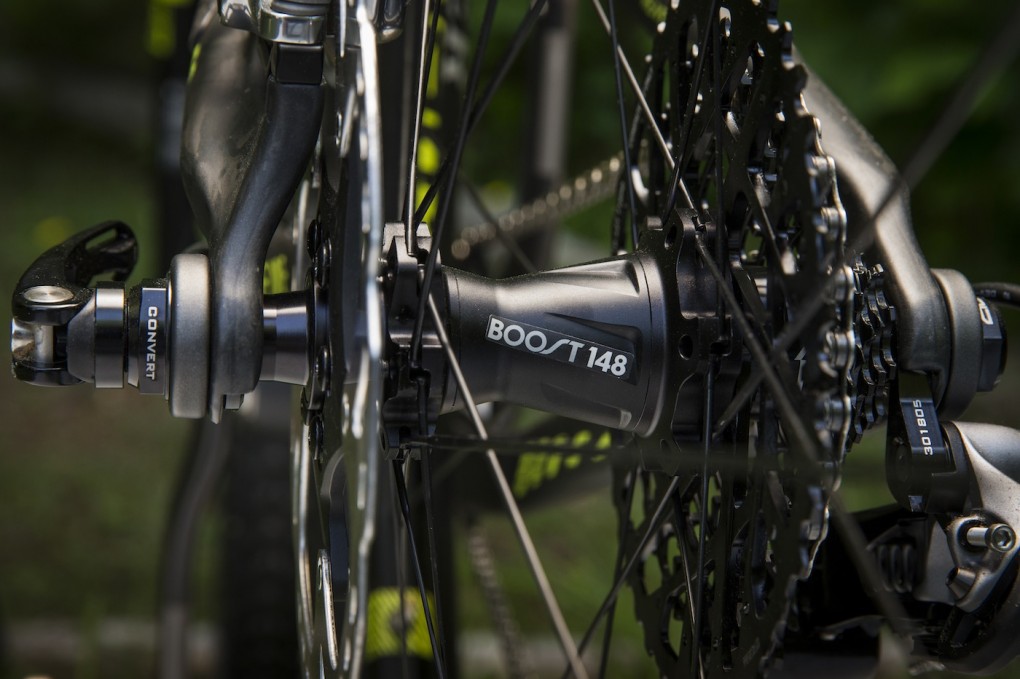
Are “Perfect 29ers” only for Trek fans? No, this is a non-proprietary interface and being the all-round good bunch they are, Trek are welcoming other manufactures to embrace the new width. Trek say that six manufacturers are already prototyping wheels and some crank manufacturers have chainrings and spiders nearly ready to hit the shelves. Trek also point out that this is aimed at aggressive 29ers and won’t be trickled down to other bikes in their range as they are already stiff enough.
Boost 148 is featured on the new Carbon Remedy 29er, the same bike piloted by Tracy Moseley to first and Justin Leov to second places at the Enduro World Series race last week in Scotland. This bike adds RE:AKTIV and BOOST 148 to an already impressive line up of features, like DRCV and ABP (Active Braking Pivot).
The carbon version benefits from added stiffness plus a lighter frame (513g saving for a Medium frame) than the previous aluminium Remedy. Perhaps more importantly, a much refined look with clean, flowing lines, and internal cable routing, putting it up there with the best-looking long travel 29ers.
Trek Fuel bikes are currently working their way to your local bike shops and Remedy and Lush bikes will have the official ranges launched mid July.
Pricing for Fuels starts at £1500, spread across 16 models in the range (sky-rocketing to £7000 for a Project One finish). RE:AKTIV is available on 9.0 and upwards models, starting at £3000.
Expect more info on Remedy and Lush bikes soon, all we know so far is that the ranges will start at £2000 and £1700 respectively.




